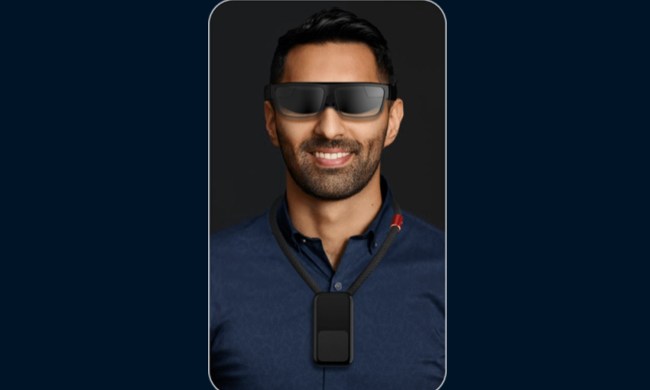“High- and mid-range frequencies came through the G35 pretty well, but lows were muddy...”
- Attractive
- yet rugged design; technologically advanced; integrated volume control and mute button
- Heavy and uncomfortable to wear for long periods; muddy bass response
Summary
Logitech’s G35 Surround Sound Headset is jam-packed with features including Dolby surround sound; user-definable profiles; a spring-steel headband; and a USB interface that keeps the audio signal in the digital domain until it reaches the headphones. By performing the digital-to-analog conversion in the headphones, Logitech eliminates any chance that the audio will be polluted by electrical noise radiating inside the computer.
The downside to this approach is that also bypasses any investment you might have made in a high-quality sound card, such as the absolutely stellar Asus Xonar Essence STX we reviewed in February.

The G35’s earmuffs are a circumaural design (meaning that they wrap around your outer ear, instead of resting on top of it). This helps isolate you from the distraction of outside noises while preventing the audio that you’re hearing from leaking out and disturbing other people around you. Although Logitech claims the headset is capable of delivering 7.1-channel audio, each muff has only physical speaker inside: a 40mm driver with a 15mm voice coil.
The demo software does a pretty good job of convincing you that the device is capable of positioning audio events in front of as well as behind your head, but the reality is altogether different. We weren’t at all fooled while watching movies on DVD (which actually do have surround-sound soundtracks) or while playing games (most of which are now encoded in simple stereo anyway, with very few games utilizing the types of positional audio algorithms—such as Creative Labs’ EAX—that used to drive the sale of so many high-end sound cards.)
Features
Using a USB interface instead of a simple audio plug provided Logitech with the opportunity to take the headset concept a lot further than a pair of headphones with a mic attached. The manufacturer’s software allows you to program buttons located on the left earmuff. The G1, G2, and G3 buttons can be programmed to control (and in some cases, launch) a media player, including iTunes, Windows Media Player, Win Amp, PowerDVD 8.0, and WinDVD 9.0. The buttons can be programmed to start, stop, and pause; skip forward and back between tracks and chapters; and so on. The 10-foot cable is plenty long for gaming and other applications where you’re relatively close to your computer, but it needs to be a wee bit longer to reach from the front-panel USB port of a home-theater PC to the couch in the average living room.

The left earmuff also hosts a switch for turning the Dolby surround-sound on and off, a very handy mute button for the speakers, and the best-designed volume-control thumbwheel we’ve encountered on a headphone. The unidirectional microphone is mounted on a semi-flexible boom that is sufficiently rigid that it can smoothly swing up and away from your mouth, but it can also be bent and twisted into the optimal position for your speaking style. The mic automatically mutes when the boom is pivoted to the up position, and there’s an LED on the end that can be programmed to remain lit, remain off, or glow only when the mic is muted.

The G35’s headband is fabricated from spring steel and is stamped with both detents and numbers that make it easy to quickly reset the headset to the right size for your noggin. The headband and earmuffs are generously padded with vinyl-covered foam, and Logitech provides two additional headband pads (they attach with Velcro) to help achieve a custom fit. The matte-black finish resists fingerprints and is very attractive; but with all that technology crammed inside, it’s no surprise that the G35 is heavy: We measured it at 12 ounces, not including the cord. Between the weight and the vinyl-covered earmuffs, which don’t breathe very well, we looked forward to taking them off after a long night of gaming. We also had a problem with the vinyl squeaking every time we moved our head as it rubbed against the arm of our eyeglasses.

We tested the microphone quality by recording ourselves speaking using the open-source audio-editing program Audacity. We detected a very slight echo in our recordings, but the directional mic did an amazing job of rejecting background noise—even when that noise was music coming from a pair of powered speakers less than two feet from the mic. Experimenting with the voice-changing software was goofy fun for a few minutes, but we can’t imagine having any long-term use for it—unless it would be mercilessly annoying an opponent in a multiplayer game.
Audio quality through the headphones was marginally higher than the mic’s performance. We used a Sennheiser HD-555 (street price $90) for our comparison, which delivered significantly better performance. High- and mid-range frequencies came through the G35 pretty well, but lows were muddy and sufficiently ill-defined that we would never recommend the G35 for critical listening. But to be fair, that’s not what the G35 is really designed for.
Pros:
- Programmable button
- USB interface eliminates problems with electrical noise
- Rugged and attractive construction
- Handy volume control and mute button
- Mic is fabulous at rejecting background noise
Cons:
- Heavy
- Uncomfortable for extended gaming sessions
- Muddy bass response
- USB interface takes your sound card out of the equation


